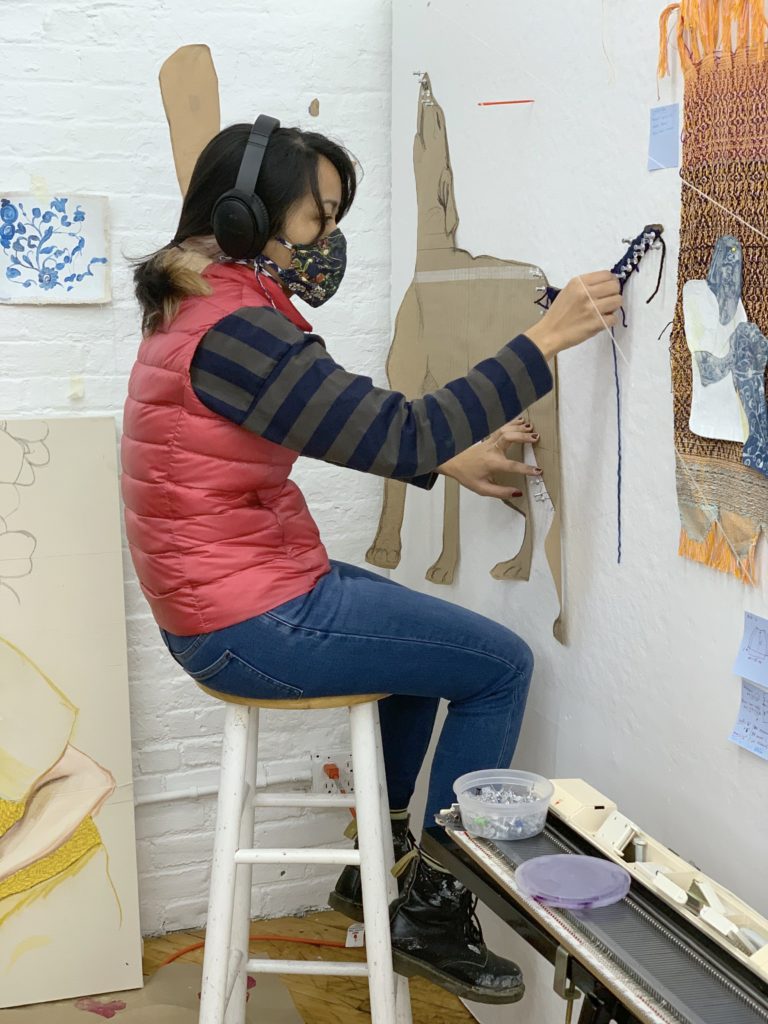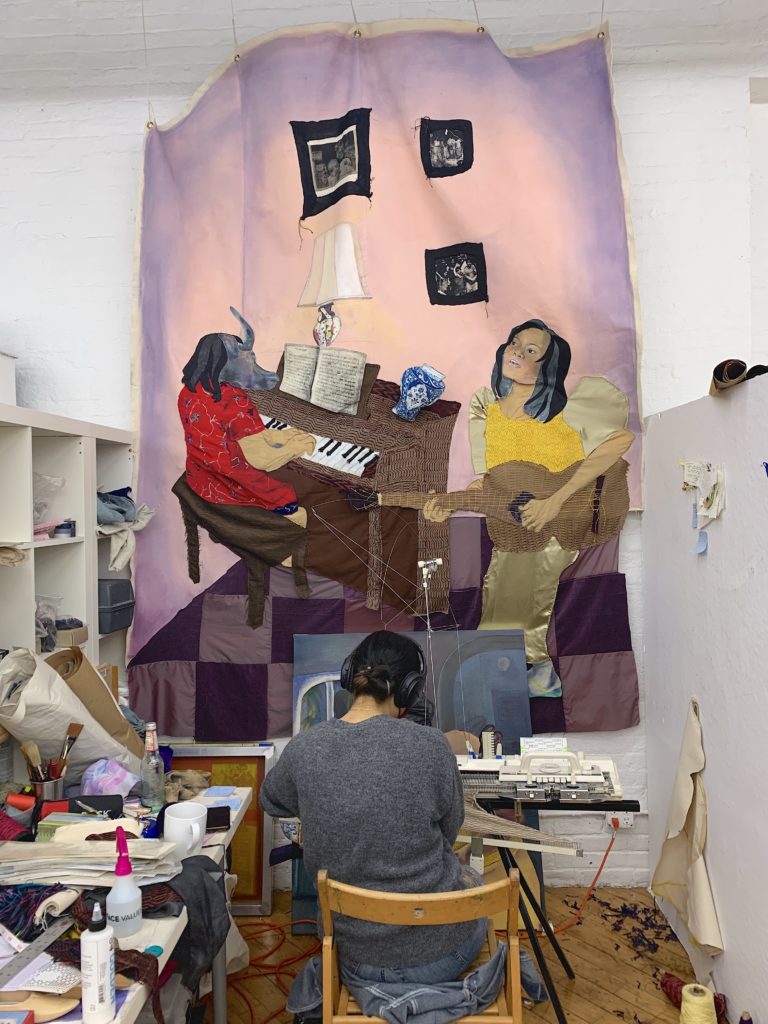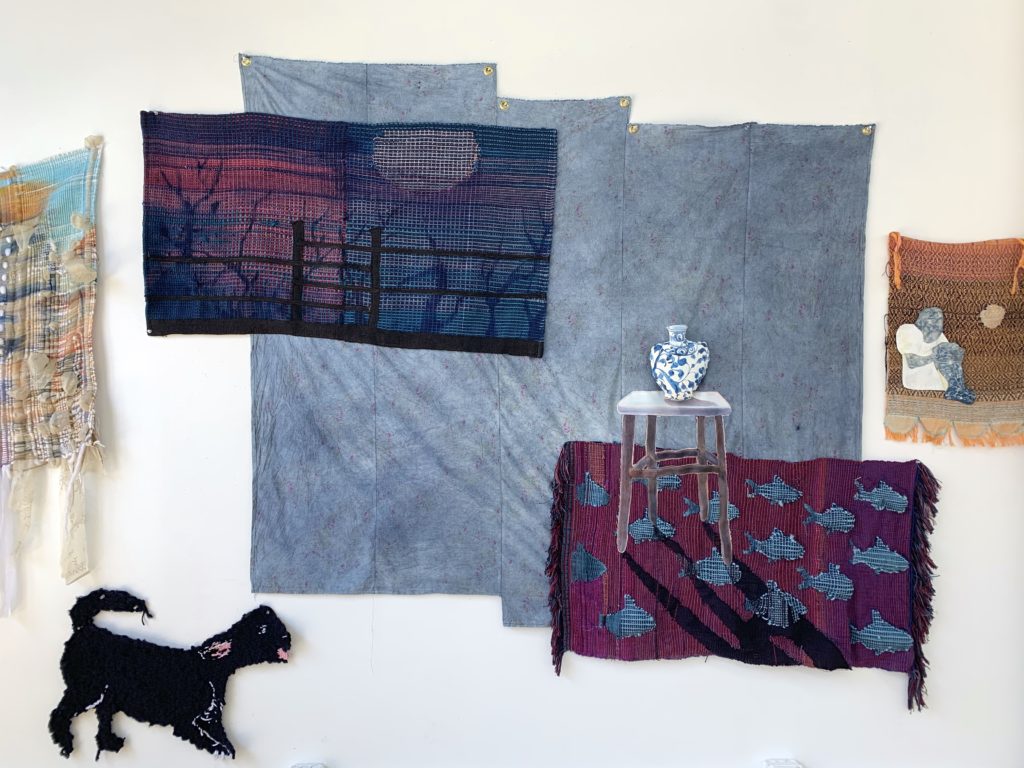AIR Highlight: Jeanne F. Jalandoni
This conversation took place on June 28, 2021 at the Textile Arts Center with Jeanne F Jalandoni and Isa Rodrigues
Video Visual Description:
Footage of Jeanne F Jalandoni, a Filipino American woman with her hair down, wearing a white t-shirt and a black face mask. In the foreground on the right hand side is the blurry silhouette of Isa’s light face and dark curly hair. In the background, there are some of Jeanne’s textile paintings hanging on the wall, including a large scale work depicting a woman wearing a yellow traditional Filipino terno. Some points of the video span around textiles as they are described in the interview.
Jeanne F. Jalandoni (she/her) is an artist working primarily with paint and textile based in Uptown Manhattan. In her practice, Jeanne reflects on Filipino history and her personal experiences as a 2nd generation American to comprehend her own bicultural identity, and challenge Filipino identity. By referencing food, national symbols, historical and ancestral archives, her work invites viewers to question bicultural tangibility.
Jeanne holds a BFA in Studio Art from New York University (2015). In 2019 she was a Real Art Ways Grant Recipient (Hartford, CT), and had a solo show entitled, Sowing Mythology. She was also a recipient of the Lower Manhattan Cultural Council Creative Engagement Grant, which was used towards her curatorial debut, Cultural Cousins: a show of Latinx and Filipinx artists (2019; New York, NY). Jeanne also co-curated The First Picture of You, 1990 at the Philippine Center of New York (2019), and exhibited work in Asia Society Texas Center's first Filipino-themed show, Super Sarap (in partnership with Erica Broussard Gallery, curated by Patricia Cariño Valdez; 2019). Jeanne was an artist-in-residence at 36 Chase and Barns Residency (2018; North Adams, MA), and the Textile Art Center (2021; Brooklyn, NY).
Isa Rodrigues (she/her) is the co-Executive Director of the Textile Arts Center
Isa: Hi Jeanne. I’m so excited to be in conversation with you surrounded by your work. Do you want to start by introducing yourself and your practice?
Jeanne: Thank you Isa! Hi everyone, my name is Jeanne Jalandoni. I’m a painter and an artist born and raised in New York City. My work revolves around being Filipino American and what does that mean to me culturally, and it usually manifests in representations of portraiture and figures, New York City experiences, as well as my own family experiences. It is also a response to my research on US and Spanish imperialism in the early 1900s and reclaiming those narratives that often dehumanize Filipino bodies.
Isa: Jeanne, when did you start working with textiles? And what drew you to incorporate fiber and fiber techniques into your work?
Jeanne: So, I have a big background in painting. And thinking about this theme of multiple realities and bi-cultural identity I wanted to expand that visually as well. And I feel like painting was limiting in certain ways. In 2018 I started experimenting with making plush objects and putting them on my paintings, and even then it still didn’t feel like enough. So coming to the Textile Arts Center’s residency, I was able to learn how to create my own textiles, weavings, knits and realize that this is the perfect method to gain my authority in telling my own narrative. And also, literally play with different realities of the surfaces of the painting. It just seems like the perfect fit and I’m in love and I’ll forever do this. (laughs)
Isa: Thinking about your application for the program, there was already a very textile-y quality on your work. I’m thinking specifically about this one tapestry that it really felt that you were fusing the two worlds, like the painting and textile work. Nine months later, and having learned so many more techniques, do you have a preferred textile technique?
Jeanne: It’s a very difficult question, because I love jumping around from weaving to knitting to painting. I think right now I’m obsessed with the knitting machine and figuring out how to create many textures and also pictorial images. I think that fun thing about it is that you can just do it really quickly and it’s all in one go. And that’s really magical and mind blowing to me. I’m really interested in bringing that to the sort of mainstream art scene and incorporating it with the rest of my paintings.

Isa: What has been the focus of your research and studio practice over the last nine months here at TAC?
Jeanne: During the last nine months I’ve actually been preparing for a solo show with Taymour Grahne Projects . I wanted to create a whole new body of work that exhibited my textile work and the new techniques that I’ve learned. I’ve never done weaving or knitting before this residency and it has been a big part of my whole practice now that I think that I wanted to just focus on making it shine and also bringing out the goals in my art practice as well.
Isa: I feel like your use of certain techniques like machine knitting and even the weaving really enhance the narrative quality of your work. Do you want to speak a little bit more about that too?
Jeanne: Yeah! So one of my favorite pieces that I made here (at TAC) is titled 'Hating Gabi' which translated to 'Midnight' from Tagalog. In that piece there’s a scene of these two figures that are playing the piano piece, "Hating Gabi". And they are playing on instruments from my childhood. So, the piano that I machine knitted is referenced from a photograph of the very first piano that I had. And the guitar is based off of my mother’s first classical guitar. So this painting documents these objects as sort of portraits of my family. And I think by machine knitting them it was also my way of gaining authority over these objects and my narrative. And that has been really important and really fun for me.

Isa: Jeanne you were a constant presence in the studio over this year (laughs). You were so prolific, you were always here. I’d love to hear more about your experience during the residency and if there was any highlight that you’d like to share.
Jeanne: Oh my goodness, yeah I feel like I lived here (laughs) I feel like one of my favorite highlights, generally, was basically bothering the other artists about their specialties and their own craft and practice. Specifically I bothered Clare a lot when it came to weaving. When I was first learning double weave, she helped me tension my warp. And it was really out of place and she helped me hang a million different objects out of my warp. So with that I created this weaving that had plush fish on it and it was so mind blowing to me to know that you could create plush objects in weaving, you don’t have to add it on. I used a lot of scrap knits and fabric to stuff those fish. It feels really cool that I could just create it all from scratch.

Isa: I remember too while you were weaving those fishes that you kept encountering all these tension problems and you were super resourceful in solving them using everything as weights, from jugs of water,... it was a whole sculpture! (laughs) Do you want to speak a little more about that?
Jeanne: It was kind of a scarring experience, because I just didn’t know what was going on (laughs). But yeah, we had jugs of water on it, different types of weights, I think I had some knitting tools that I tied up and hung on it. I even used some of my painting tools and paint tubes on it and I felt like such a traitor to painters. (laughs) Yeah, it was crazy and I really hope I don’t have a tension problem like that again.
Isa: Over the last weeks we have been discussing the plans for the final exhibition in September. Can you share a little bit more about what you’re planning to exhibit?
Jeanne: For the final exhibition, I will be creating a fabric mural installation. And that will look like three large women having a Filipino party. Visually what that means is a ton of Filipino food made out of textiles and karaoke. I’m planning on creating the karaoke machine with textiles as well. So yeah, it will be interesting.
Isa: We’re currently seating in a preview of that scene. One of the figures right behind you is completed and she’s wearing this traditional Filipino dress that has been a constant in your work. Can you speak more about the importance of this dress in your work and in your practice?
Jeanne: So the yellow dress is actually my grandmother’s dress. I never met my grandmother before so when my parents gifted this dress to me and I put it on (and) it fit perfectly, that kind of felt really eerie and ghostly, like I was embodying her spirit in a weird way. I like to think of these figures as guardians of history. They’re not necessarily self portraits but they do contain a lot of my family history in them. For example, the necklace that this figure is wearing is my uncle’s house that me and my family often took vacations at. Also, there’s a knitted pattern on her vest that (depicts) my mother holding me as a baby. I really like that this dress is very significant to me in terms of my personal history.
Isa: Do you have any upcoming projects or plans that you’d like to share, for after the residency?
Jeanne: I have a solo show with Taymour Grahne Projects which will open on August 12 and that will be a virtual show. But other than that, I just plan on sleeping and vacationing because this residency has been very intense. And also working on the final exhibition.
The TAC AIR 12 Final exhibition, Considering Mass and Density, will be on view at the Textile Arts Center from September 13-26, 2021.